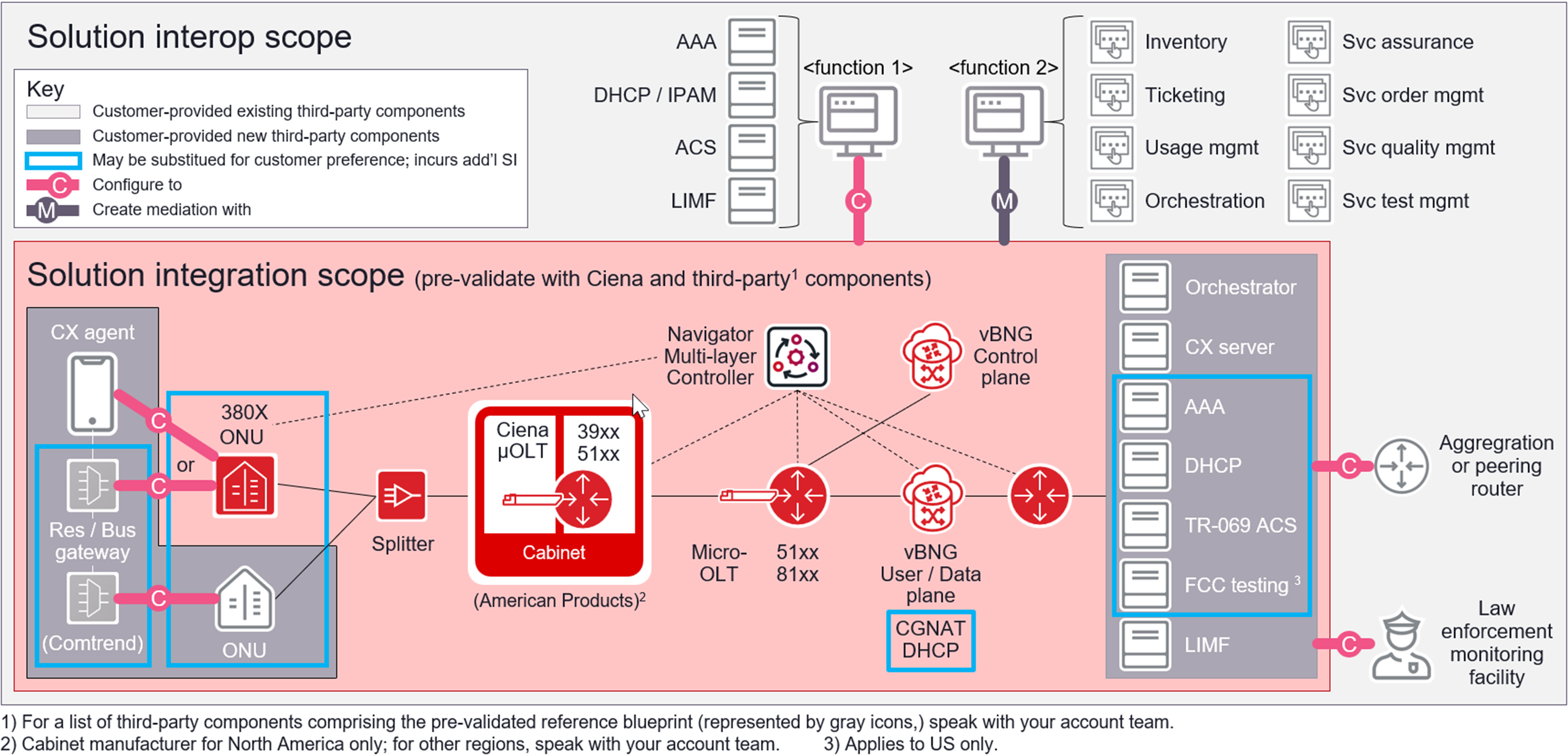Identifying the value of a reference blueprint when deploying broadband service
One of the most disruptive aspects of the surging proliferation of broadband networks is who is deploying those networks. While the expectation is that big regional and national carriers do this, many local and rural service providers are now entering the space. Further reshuffling things is the abundance of ‘non-traditional’ players, such as state, provincial, or tribal governments, municipalities, or utilities. Governments have heavily incentivized these new and existing providers to offer broadband in the interest of community service, augmenting an already enormous consumer-driven demand.
Of course, incentives are one thing, but successful deployment and service delivery is another. Our aim in this blog is to equip you, the technically-oriented decision maker, with ‘insider’ insights to ensure a smooth, timely, and profitable broadband rollout.
It’s more than just residential
The push for broadband extends beyond the incentives-driven residential market. Enterprises and data centers have also created new use cases for broadband technologies. For instance, Passive Optical Network (PON) enabled broadband can be combined with SD-WAN for cost-effective corporate connectivity. PON can also be used to manage the Data Communications Networks (DCN) in data centers. Enabling Wi-Fi in enterprise workspaces with Passive Optical LAN (POLAN) is yet another example. As PON roadmaps show increases in speed to 25Gb/s and beyond, use cases will undoubtedly expand to further benefit the enterprise.
Whether for the residential or enterprise market, broadband is challenging to deploy for anyone, and especially for those new to it. Some situations you are likely to encounter include:
- Performance― Single-source turnkey solutions trade performance and efficient scalability for simplicity. But navigating a best-of-breed approach to unlock higher performance while achieving cohesive interworking can be complex.
- Integration― Beyond integrating new 3rd party equipment (particularly if starting from a single-source basis), you may face challenges with operational workflow complexity, end-to-end performance management and troubleshooting, API sprawl, and OSS integration.
- Migration― Moving from DOCSIS, EPON, and GPON to 10G PON, and higher, requires new architectures, processes, and tools.
- Training― A clean rollout and sustained smooth operation requires staff with unique skillsets and technical resources.
Two steps to assure a successful implementation
Fortunately, two key considerations can significantly enhance the likelihood of a successful deployment: a robust broadband reference blueprint that can be tailored to your needs and a services team with a proven track record in packet and broadband services.
To start, let’s take a closer look at how a reference blueprint can help.
The value of a customizable pre-validated reference blueprint
Designing a broadband network from scratch requires deep and specific knowledge, processes, and tools. None of these come easily or cheaply, which can challenge the newer provider. One way to solve this is with a single-vendor turnkey approach—but the tradeoffs in performance, cost, and choice limitations from vendor lock-in can be prohibitive.
Another approach is to leverage a reference blueprint that identifies and pre-validates the interworking of the primary components as much as possible, which then baselines the solution documentation. Rather than starting from scratch, this forms a lab-tested foundation on which you can build a customer-specific design. This approach significantly reduces risk, and by starting customization deeper in the design process, also cuts weeks or months from your deployment schedule. Generally, reducing risk and cutting time-to-market are mutually exclusive; it’s rare to deliver both.
Let’s take a look at the most important aspects of a reference blueprint that need to be considered.
1. Network infrastructure
The physical layer of a broadband network typically contains infrastructure with these components:
- Physical network infrastructure such as fiber, patch panels, splitters, attenuators, cabinets, housings, and cables.
- Active networking elements including customer premises equipment (CPE), residential and/or business gateways, access, and transport network elements such as PON optical line terminals (OLTs), optical network units (ONU) / terminals (ONT), and transport switches and routers.
- Servers for hosting including:
- Virtual network elements such as virtual Broadband Network Gateway (vBNG), Dynamic Host Configuration Protocol (DHCP), Authentication, Authorization, and Accounting (AAA), TR-069 ACS, and LIMF.
- Operations Support Systems (OSS) functions including service fulfillment and assurance, and inventory.
- Business Support Systems (BSS) functions including ticketing, billing, and customer management.
- Cloud platforms for on- and off-network services, including subscriber services, as well as hosted OSS/BSS applications.
This physical infrastructure is overlayed with software-enabled solution components necessary to automate the service lifecycle and derive value from the network including:
- Network management and control functions such as AAA, DHCP server for IP Address Management (IPAM), BNGs for subscriber management, ACS, LIMF, and FCC testing.
As an example, Ciena’s reference blueprint is illustrated below:

Figure 1. Ciena's reference blueprint, expanded view
2. Pre-validation
As mentioned above, leveraging a reference blueprint as a baseline de-risks design by pre-validating component interworking for end-to-end service delivery. For instance, pre-validation ensures that the vBNG, AAA, and LIMF can work together to enable lawful intercept; or the OLT, vBNG, and metro routing jointly provide fast failure recovery. You could do this yourself, but it’s expensive, time-consuming, and requires specialized skills. Relying on an experienced partner eliminates your need to purchase and maintain expensive lab equipment, as well as training staff to use it, which is especially crucial considering these are episodic rather than regular exercises. This approach benefits both the seasoned service provider as well as newer entrants.
3. Customizability
A well-conceived reference blueprint enables you to substitute select components (see Fig 1, blue boxes) with those of your preference. Naturally, this requires review and acceptance by your solution partner, likely incurring additional system integration charges. This provides the best of both worlds—a tested baseline foundation and the choice of best-of-breed solution components. Regional regulations, environmental factors, architectural preferences, existing vendor relationships, existing network configuration, components preferred and/or pre-integrated by OSS/BSS vendors are some reasons you may want to customize the pre-validated blueprint baseline.
Providers seeking further customization can do so by engaging your partner’s systems integration capabilities for solution validation.
4. Baseline documentation
As a further tangible benefit, pre-validation generates baseline documentation and other artifacts, including high-level design (HLD) and low-level design (LLD) documents, configuration files, and an acceptance test plan (ATP), used to architect and configure the solution elements into the production network.
- HLD documents typically cover broadband access solution design, component descriptions, PON architecture, supporting functions (such as vBNG, DHCP, etc.,) and high-level descriptions of planned subscriber services.
- LLD documents address network connectivity, including Quality of Service (QoS) / Hierarchical QoS (HQoS) profiles and application mapping, DHCP and AAA server configuration, vBNG configuration, LIMF integration, management access configuration, network management and orchestration (if applicable).
- ATP documents generally contain test procedures to verify the solution works as specified once it is deployed and turned up in the production network.
5. OSS/BSS Integration
A strategic partner should also provide consultation, middleware development, and/or any custom software to integrate the broadband solution into your existing OSS/BSS. This should provide API consolidation among and translation between solution elements and your OSS/BSS, data model mapping between these elements and your OSS/BSS resource model. They should also provide value-added functionality such as workflow optimization and data pre-processing and enrichment between ‘to’ and ‘from’ systems. This approach simplifies integration while reducing its time and cost.
Ciena Services as your strategic partner
While a robust reference blueprint is a critical starting point for successfully deploying new broadband service, its practical benefit depends on knowing how to use it. Fully leveraging that customizability requires a strategic partner who can help you make the right selections to determine which third-party device choices will function well in the network. This is especially true in Ciena’s case because, as discussed above, our blueprint is designed to work in the ‘real world’ of multivendor customer preferences rather than as a rigid self-promotional map.
Additionally, beyond establishing a reference blueprint and its accompanying documentation, you still must market your offering and deploy, support, and manage your expanded network. Ciena’s Services for Broadband Access fully addresses this full scope of requirements.
Meeting time-to-market milestones is crucial, particularly as incentive funds for broadband generally come with deadlines for successful implementation. Ciena Services helps assure you hit those milestones with our combination of skilled people, proven processes, and advanced tools. As part of those processes, a thoughtfully developed and comprehensive reference blueprint de-risks design while accelerating deployment as well as all the associated operational and financial benefits.
Simply put, Ciena Services allows operators like you to focus on core competencies while successfully reaching these goals.






